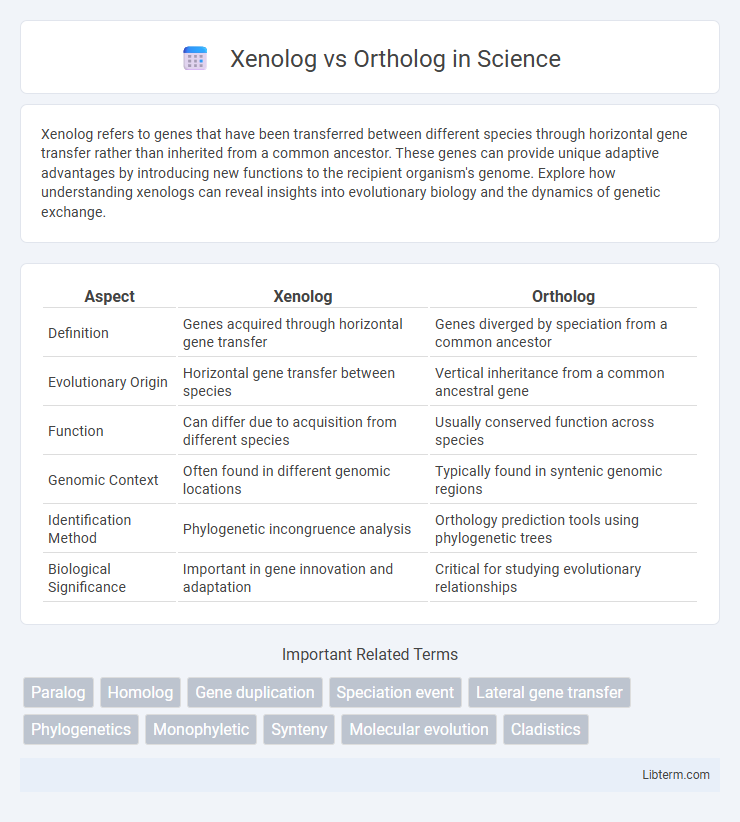Xenolog refers to genes that have been transferred between different species through horizontal gene transfer rather than inherited from a common ancestor. These genes can provide unique adaptive advantages by introducing new functions to the recipient organism's genome. Explore how understanding xenologs can reveal insights into evolutionary biology and the dynamics of genetic exchange.
Table of Comparison
| Aspect | Xenolog | Ortholog |
|---|---|---|
| Definition | Genes acquired through horizontal gene transfer | Genes diverged by speciation from a common ancestor |
| Evolutionary Origin | Horizontal gene transfer between species | Vertical inheritance from a common ancestral gene |
| Function | Can differ due to acquisition from different species | Usually conserved function across species |
| Genomic Context | Often found in different genomic locations | Typically found in syntenic genomic regions |
| Identification Method | Phylogenetic incongruence analysis | Orthology prediction tools using phylogenetic trees |
| Biological Significance | Important in gene innovation and adaptation | Critical for studying evolutionary relationships |
Introduction to Xenologs and Orthologs
Xenologs are genes acquired by horizontal gene transfer between different species, often resulting in novel functions that contribute to genetic diversity. Orthologs are genes in different species that evolved from a common ancestral gene through speciation, typically retaining similar functions across species. Understanding the distinction between xenologs and orthologs is crucial for comparative genomics, evolutionary biology, and functional gene annotation.
Defining Xenologs: Key Characteristics
Xenologs are genes acquired by horizontal gene transfer between different species rather than inherited from a common ancestor, distinguishing them from orthologs that arise through speciation events. Key characteristics of xenologs include their presence in unrelated species, divergence driven by horizontal transfer, and potential adaptation to new functional contexts. Identifying xenologs involves detecting atypical phylogenetic relationships and sequence compositions that contrast with expected vertical inheritance patterns.
Understanding Orthologs: Essential Features
Orthologs are genes in different species that originated from a common ancestral gene through speciation, maintaining similar functions across species. Key features include high sequence similarity, evolutionary conservation, and functional equivalence, which make orthologs critical markers for phylogenetic studies and comparative genomics. Understanding orthologous relationships helps in accurately predicting gene function and tracing evolutionary histories in bioinformatics analyses.
Evolutionary Origins of Xenologs
Xenologs originate from horizontal gene transfer events, where genes move between species through mechanisms such as viral infection, conjugation, or transformation, creating gene copies in unrelated lineages. Unlike orthologs, which result from speciation and diverge following a common ancestral gene, xenologs reflect evolutionary histories influenced by lateral gene transfer, often seen in prokaryotes and some eukaryotes. Understanding the evolutionary origins of xenologs is crucial for interpreting phylogenetic relationships and reconstructing gene family histories impacted by non-vertical inheritance.
Evolutionary Pathways of Orthologs
Orthologs arise from speciation events, representing genes in different species that evolved from a common ancestral gene, maintaining similar functions across evolutionary lineages. Their evolutionary pathways reflect divergence through adaptation to distinct environmental pressures while preserving core biological roles. This contrasts with xenologs, which result from horizontal gene transfer and often exhibit functional shifts unrelated to vertical descent.
Functional Differences between Xenologs and Orthologs
Xenologs are homologous genes that arise from horizontal gene transfer and often diverge functionally due to adaptation to different host environments or selective pressures. Orthologs, on the other hand, originate from a common ancestral gene through speciation and generally retain similar functions across species, reflecting evolutionary conservation. Functional differences between xenologs and orthologs are highlighted by the greater variability and potential novel roles in xenologs compared to the typically conserved biological roles found in orthologs.
Methods for Identifying Xenologs and Orthologs
Methods for identifying xenologs and orthologs leverage comparative genomics and phylogenetic analyses to distinguish gene evolution pathways. Orthologs are detected by constructing phylogenetic trees and identifying genes in different species that diverged through speciation events; tools like OrthoFinder and InParanoid specialize in ortholog prediction. Xenolog identification often involves detecting horizontal gene transfer events using sequence similarity searches combined with incongruent phylogenetic patterns, employing algorithms such as HGTector and DarkHorse to pinpoint genes acquired from distant lineages.
Importance in Comparative Genomics
Xenologs and orthologs are critical in comparative genomics for understanding gene evolution and functional conservation across species. Orthologs arise from speciation events and typically retain similar functions, making them key for tracing evolutionary relationships and predicting gene function. Xenologs, originating from horizontal gene transfer, reveal gene exchange between distantly related organisms, providing insights into adaptive evolution and genome dynamics.
Applications in Evolutionary Biology and Biotechnology
Xenologs and orthologs provide critical insights into gene function and evolutionary relationships; orthologs, derived from speciation events, are pivotal for tracing species divergence and reconstructing phylogenies with high accuracy. Xenologs, resulting from horizontal gene transfer, reveal gene flow across species boundaries, enhancing understanding of adaptive evolution and microbial ecology. In biotechnology, orthologous genes serve as reliable targets for functional annotation and protein engineering, while xenologous genes offer novel genetic material for synthetic biology and the development of cross-species gene transfer techniques.
Future Perspectives in Xenolog and Ortholog Research
Future perspectives in xenolog and ortholog research emphasize the integration of advanced computational methods and high-throughput genomic data to improve the accuracy of gene function prediction and evolutionary analysis. Emerging techniques such as machine learning models and CRISPR-based functional assays will enable deeper understanding of gene transfer events in xenologs and conserved molecular functions in orthologs across diverse species. Enhanced comparative genomics and phylogenetic frameworks promise to reveal novel insights into gene evolution, adaptation mechanisms, and their applications in biotechnology and medicine.
Xenolog Infographic

 libterm.com
libterm.com